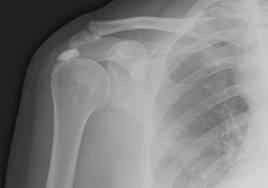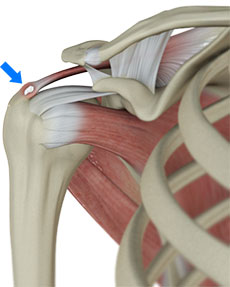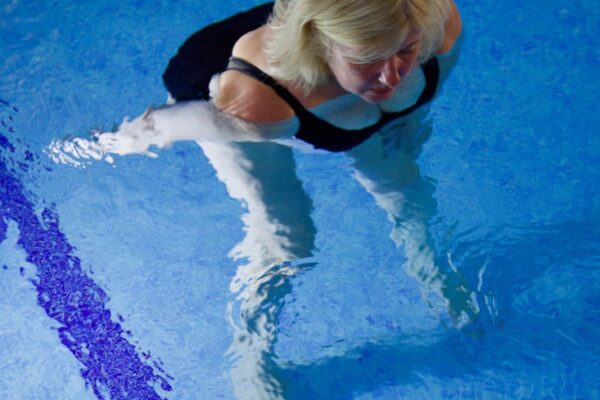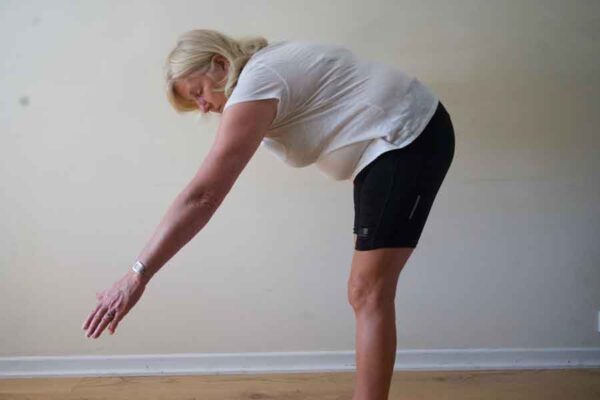Extracts from Mr Richard Sinnerton FRCS – Shoulder specialist London
Sometimes people will wake up with an acutely painful shoulder for no particular reason at all: they have not had a fall or overdone anything they can remember. They can barely move and painkillers do not seem to touch the pain.
There are just two conditions that can cause a severe and acute painful shoulder so suddenly which are Calcifying Tendonitis and Brachial Neuritis: a simple x-ray will show which it is and how to treat it.
Calcifying Tendonitis
What causes it?
Calcifying tendonitis is where the main tendon that lifts the arm up in the air has been rubbing (or impinging) away quietly, possibly for years, without you knowing anything about it. In simple terms, the tendon bleeds a little and the body changes the blood slowly into chalk. It is more like toothpaste consistency than blackboard chalk and it can sit in the tendon for years without causing any issues. Until suddenly it causes acute pain.
What then happens is the chalk starts to be squeezed or extruded out of the tendon ( supraspinatus tendon) into the sub-acromial space and sets off the horrific inflammatory reaction causing the severe pain that makes every movement of the shoulder excruciating.
Who is affected?
No one is sure why some people develop calcific tendonitis but it is more common in people who play sports or routinely raise their arms up and down for work but calcific tendonitis can affect anyone.
Most commonly seen in adults between 40-60 years old with women much more likely to get it then men.
Treatment
It is, however, very treatable and a simple steroid and local anaesthetic injection into the sub-acromial space can get rid of it very quickly. The injection may not eliminate the pain completely but it is usually much improved within a few hours.
About 10% of people will need surgery a few weeks later to get rid of the residual discomfort and you may need an arthroscopic subacromial decompression which comprises of shaving away a little bit of bone to make more space for the tendons to glide freely in.
This is normally done arthroscopically via a small incision and a tiny camera. The camera will guide the surgical tool in removal of the deposit.
Your recovery period will depend on the size, location, and number of calcium deposits. Some people will return to normal functioning within a week or so and others may still experience some pain that continues to limit their activities.


Physiotherapy
You will be shown the correct exercises by the physiotherapist to regain the full range of motion of the your shoulder.
These may include some easy pendulum swinging exercises that do not cause any pain and ease the stiffness in the shoulder. Hydrotherapy can be another easy way to exercise and regain movement.
Shoulder Exercises- mobilising exercises
Shoulder Exercises in water-Hydrotherapy
Rehabilitation after surgery
Recovery time after surgery varies from person to person and may take up to 3 months
Recovery from arthroscopic surgery is generally quicker than from open surgery.
After either open or arthroscopic surgery, your doctor may advise you to wear a sling for a few days to support and protect the shoulder.
You should also expect to attend physiotherapy sessions for 6-8 weeks. Physiotherapy usually begins with some stretching and very limited range-of-motion exercises. You will typically progress to some light weight-bearing activity after four weeks.


Another cause of acute pain can be:
Neuralgic Amyotrophy
If the X-ray does not show any chalk deposits then you have a condition called Brachial Neuritis or Parsonage Turner Syndrome or Neuralgic Amyotrophy. These are all terms that cover the same condition in which a virus inflames the nerves and muscles around the shoulder causing agonising pain. There really is not anything that can be done for this condition other than managing the symptoms until it sorts itself out. You may be advised to see a Pain Management Specialist as they have the skills to organise an excellent regime of medication that can help control the pain.
This acute and severely painful condition is NOT a frozen shoulder – they do not come on like this. The inability to move the shoulder is due to pain rather than a freeze of the shoulder.

